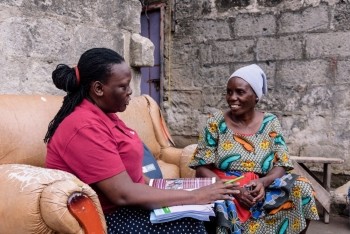General Resource
Best practices in programming for orphans and vulnerable children: A compendium of interventions and lessons learned from the USAID Kizazi Kipya project
December 12, 2021
Children, Health, HIV/AIDS
The USAID Kizazi Kipya Project was implemented during a dynamic period in the global and Tanzanian response to HIV. In 2015, UNAIDS launched the ambitious 90-90-90 goals and the global community committed to end the AIDS epidemic by 2030. In response, PEPFAR prioritized activities with demonstrated, data-driven evidence that contributed to the testing, treatment, and viral suppression goals. Kizazi Kipya increasingly focused on evidence-based approaches for monitoring HIV status among orphans and vulnerable children (OVC) beneficiaries, assessing their risk of HIV infection, and facilitating access and retention in anti-retroviral therapy (ART).
PEPFAR also used data on children and adolescents living with HIV to change ongoing projects to improve results and reach scale. Kizazi Kipya experienced significant year-to-year changes in funding levels, geographic scope, and targets, requiring the project to be adaptable while continuously striving to reach the 90-90-90 goals by the project's end. By its fourth year (2020), Kizazi Kipya was the secondlargest OVC program in the world (after Nigeria), reaching nearly 988,875 people, or almost 15% of the 6.7 million people supported by all PEPFAR OVC programs.
When the project started in 2016, Tanzania had elected new leadership who demanded that nongovernmental and civil society actors demonstrate accountability and alignment with national development goals. In response, Kizazi Kipya worked closely with the President's Office - Regional Administrative and Local Government (PO-RALG). Together, PO-RALG and Kizazi Kipya revitalized the government system for integrated case management (CM) at council, ward, and village levels. Over the project lifespan, Community Case Worker volunteers challenged the idea that vulnerable households would always need help. Kizazi Kipya's CM approach supported children and households along a pathway out of poverty, supported them to develop resilience, showed them how to harness local resources as needed, and celebrated with them when they graduated from external support.
Reflecting USAID's goals for sustainability and country ownership, Pact partnered with 45 Tanzanian civil society and faith-based organizations (CSOs and FBOs) to directly implement project activities through sub-grants and technical assistance. Pact and consortium partners built CSO capacity to implement tailored, HIV-centered OVC services based on household needs. As a testament to Kizazi Kipya's successful stewardship, USAID is currently developing its first partnerships with indigenous CSOs and FBOs to receive direct USAID awards to implement OVC programming in Tanzania.
The project faced an unprecedented challenge in its fourth year: Covid-19. The pandemic required Kizazi Kipya to devise strategies to minimize the risk of spreading Covid-19, maintain service delivery and impact, and mitigate Covid-19-related economic and education disruptions on OVC and their household members. Even before the pandemic, the project maintained a dedicated and creative team of staff who could quickly change course and respond to increased demands. During this trying time, they continued to demonstrate their excellence, carefully assessing activity risk, and re-organizing and coordinating implementation structures, all to minimize impact on the project's critical activities.
This document provides implementation and technical guidance to OVC program implementers to learn from and apply Kizazi Kipya's technical approaches to future large-scale OVC programs. We hope it adequately captures and commemorates the effort, commitment, and unrelenting passion of the USAID Kizazi Kipya staff and our collaborators in serving our beneficiaries.
This work is licensed under the Creative Commons Attribution-ShareAlike 3.0 Unported License. To view a copy of this license, visit http://creativecommons.org/licenses/by-sa/3.0/ or send a letter to Creative Commons, 444 Castro Street, Suite 900, Mountain View, California, 94041, USA.
RELATED RESOURCES
-
Stories of change from the Women of Ukraine project
-
Best practices in programming for people-centered justice: A compendium of interventions and lessons learned from the USAID Expanding Access to Justice Program in Somalia
-
Strategy for civil society and independent media to collaborate with the private sector
-
Brief: Priority actions for engaging the private sector to promote civic and media space
-
Proven approaches for women’s economic empowerment: Technical brief from Women Entrepreneurs Act in Cambodia
Stay Updated. Subscribe Now.
Pact's e-newsletter offers the latest on our efforts around the world to build thriving, resilient and engaged communities that are leading their own development.
